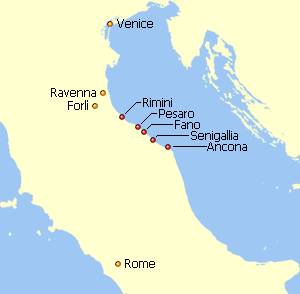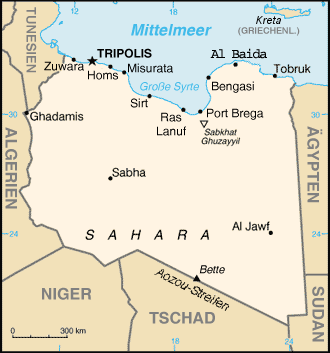|
Tocra
Tocra, Taucheira or Tukrah, is a town on the coast of the Marj District in the Cyrenaica region of northeastern Libya, founded by Cyrene. It lay 200 stadia west of Ptolemais. Today it is a coastal town west of Marj. History Founded by the Greeks and considered by some to be part of the Pentapolis of Cyrenaica, at a later period it became a Roman colony (Tab. Peut.), and was fortified by Justinian I. (Procop. ''de Aed.'' vi. 3.) Taucheira was particularly noted for the worship of Cybele, in honour of whom an annual festival was celebrated. (Synes. Ep. 3.) In the city fortifications from the Hellenistic, Roman and Byzantine periods have been found. Name Taucheira, Teucheira, Tauchira or Teuchira (Greek: , ,). Under the Ptolemies it obtained the name of Arsinoe (Arsinoë) (Greek: ), after Arsinoe II of Egypt, named by her brother and husband, Ptolemy Philadelphus. Later it became known as Tocra or Tukrah or Tokara, and then Al Quriyah or El Agouriya in Arabic. It is the s ... [...More Info...] [...Related Items...] OR: [Wikipedia] [Google] [Baidu] |
Cyrenaica
Cyrenaica ( ) or Kyrenaika ( ar, برقة, Barqah, grc-koi, Κυρηναϊκή ��παρχίαKurēnaïkḗ parkhíā}, after the city of Cyrene), is the eastern region of Libya. Cyrenaica includes all of the eastern part of Libya between longitudes E16 and E25, including the Kufra District. The coastal region, also known as ''Pentapolis'' ("Five Cities") in antiquity, was part of the Roman province of Crete and Cyrenaica, later divided into ''Libya Pentapolis'' and ''Libya Sicca''. During the Islamic period, the area came to be known as ''Barqa'', after the city of Barca. Cyrenaica became an Italian colony in 1911. After the 1934 formation of Libya, the Cyrenaica province was designated as one of the three primary provinces of the country. During World War II, it fell under British military and civil administration from 1943 until 1951, and finally in the Kingdom of Libya from 1951 until 1963. The region that used to be Cyrenaica officially until 1963 has formed s ... [...More Info...] [...Related Items...] OR: [Wikipedia] [Google] [Baidu] |
Vehicle Registration Plates Of Libya
Libya requires its residents to register their motor vehicles and display vehicle registration plates. Current plates are European standard 520 mm × 110 mm. Current Series Libya's current series of license plates entered circulation in 2013, after Libyan Revolution and the overthrow of Gaddafi. Numbers on license plates are in Latin Alphabet, and all plates carry the Arabic text ليبيا meaning ''Libya'', in Naskh Script, either on the right hand side or the right top corner. Private Vehicles Private vehicle license plates are black on white and follow the format ''# - 1 to 999999 The First number (#), a 1 or 2 digit number consists of a code corresponding to Municipality in Libya. This number is separated by a dash from the registration code, which can be 1 to 6 digits. In the city of Tripoli, due to its larger population, 7-digit registration codes are also issued. Foreigner-owned Private Vehicles Foreigner-owned Private vehicle license plates are black on ... [...More Info...] [...Related Items...] OR: [Wikipedia] [Google] [Baidu] |
Ptolemais (Cyrenaica)
Ptolemais (Greek: Πτολεμαΐς) was one of the five cities that formed the Pentapolis of Cyrenaica, the others being Cyrene, Euesperides (later known as Berenice, now Benghazi), Tauchira/Teuchira (later Arsinoe, and now Tocra), and Apollonia (now Susa). Its ruins are at a small village in modern Libya called Tolmeita (''Arabic'' طلميتة), after the ancient name.Jane Soames Nickerson (Biblo & Tannen Publishers 1968 ), p. 20 History 
[...More Info...] [...Related Items...] OR: [Wikipedia] [Google] [Baidu] |
Marj, Libya
Marj ( ar, المرج, Al Marǧ, The Meadows), also spelt ''El Merj'', generally believed to be on the site of the ancient city of Barca or Barce, is a city in northeastern Libya and the administrative seat of the Marj District. It lies in an upland valley separated from the Mediterranean Sea by a range of hills, part of the Jebel Akhdar Mountains. It has an estimated population of 85,315 (). There are a couple of banks on the main street and the main post office is in the city centre, not far from the Abu Bakr Assiddiq mosque.Pliez, Olivier (ed.) (2009) "Al Marj" ''Le Petit Futé Libye'' Petit Futé, Parisp. 237 ; in French History According to most archeologists, Marj marks the site of the ancient city of Barca, which, however, according to Alexander Graham, was at Tolmeita ( Ptolemais). Marj grew around a Turkish fort built in 1842 and now restored. During the colonial dominance of Libya (1913–41), the town was called Barce and was developed as an administrative ... [...More Info...] [...Related Items...] OR: [Wikipedia] [Google] [Baidu] |
Pentapolis (North Africa)
A pentapolis (from Greek ''penta-'', 'five' and '' polis'', 'city') is a geographic and/or institutional grouping of five cities. Cities in the ancient world probably formed such groups for political, commercial and military reasons, as happened later with the Cinque Ports in England. Significant historical cases * In the biblical Holy Land, describes the region where five cities — Sodom, Gomorrah, Zoara, Admah and Zeboim — united to resist the invasion of Chedorlaomer, and of which four were shortly after destroyed. * The Philistine Pentapolis: Ashkelon, Ashdod, Ekron, Gath, and Gaza, all combined to make Philistia. * The Doric – or Dorian Pentapolis: Kos, on the island of the same name in the Aegean Sea; Cnidus, in Caria on the west coast of Asia Minor; Lindus, Ialysus and Camirus, all three on Rhodes. * The Phrygian Pentapolis: Eucarpia, Hierapolis, Otrus, Bruzus, and Stectorium * The Pontic Pentapolis: Apollonia, Callatis, Mesembria, ... [...More Info...] [...Related Items...] OR: [Wikipedia] [Google] [Baidu] |
List Of Cities In Libya
This is a list of the 100 largest populated places in Libya. Some places in the list could be considered suburbs or neighborhoods of some large cities in the list, so this list is not definitive. ''Source:Amraja M. el Khajkhaj, "Noumou al Mudon as Sagheera fi Libia", Dar as Saqia, Benghazi-2008, pp. 118-123.'' See also *Transliteration of Libyan placenames *List of metropolitan areas in Africa *List of largest cities in the Arab world References External links * {{List of cities in the Middle East Populated places in Libya, Lists of cities by country, Libya, List of cities in Lists of cities in Africa, Libya Libya geography-related lists, Cities ... [...More Info...] [...Related Items...] OR: [Wikipedia] [Google] [Baidu] |
Arsinoe II Of Egypt
Arsinoë II ( grc-koi, Ἀρσινόη, 316 BC – unknown date between July 270 and 260 BC) was a Ptolemaic queen and co-regent of the Ptolemaic Kingdom of ancient Egypt. She was given the Egyptian title "King of Upper and Lower Egypt", making her pharaoh as well. Arsinoe was Queen of Thrace, Anatolia, and Macedonia by marriage to King Lysimachus. She became co-ruler of the Ptolemaic Kingdom upon her marriage to her brother, Pharaoh Ptolemy II Philadelphus. Life Early life Arsinoë was the first daughter of Pharaoh Ptolemy I Soter, founder of the Hellenistic state of Egypt, and his second wife Berenice I of Egypt. She was maybe born in Memphis, but was raised in the new city of Alexandria, where her father moved his capital. Nothing is known of her childhood or education, but judging from her later life as patron of scholars and noted for her learning, she is estimated to have been given a high education. Her brothers were tutored by intellectuals hired by their fathers, ... [...More Info...] [...Related Items...] OR: [Wikipedia] [Google] [Baidu] |
Populated Coastal Places In Libya
Population typically refers to the number of people in a single area, whether it be a city or town, region, country, continent, or the world. Governments typically quantify the size of the resident population within their jurisdiction using a census, a process of collecting, analysing, compiling, and publishing data regarding a population. Perspectives of various disciplines Social sciences In sociology and population geography, population refers to a group of human beings with some predefined criterion in common, such as location, race, ethnicity, nationality, or religion. Demography is a social science which entails the statistical study of populations. Ecology In ecology, a population is a group of organisms of the same species who inhabit the same particular geographical area and are capable of interbreeding. The area of a sexual population is the area where inter-breeding is possible between any pair within the area and more probable than cross-breeding with ind ... [...More Info...] [...Related Items...] OR: [Wikipedia] [Google] [Baidu] |
Former Populated Places In Libya
A former is an object, such as a template, gauge or cutting die, which is used to form something such as a boat's hull. Typically, a former gives shape to a structure that may have complex curvature. A former may become an integral part of the finished structure, as in an aircraft fuselage, or it may be removable, being using in the construction process and then discarded or re-used. Aircraft formers Formers are used in the construction of aircraft fuselage, of which a typical fuselage has a series from the nose to the empennage, typically perpendicular to the longitudinal axis of the aircraft. The primary purpose of formers is to establish the shape of the fuselage and reduce the column length of stringers to prevent instability. Formers are typically attached to longerons, which support the skin of the aircraft. The "former-and-longeron" technique (also called stations and stringers) was adopted from boat construction, and was typical of light aircraft built until the a ... [...More Info...] [...Related Items...] OR: [Wikipedia] [Google] [Baidu] |
Coloniae (Roman)
A Roman (plural ) was originally a Roman outpost established in conquered territory to secure it. Eventually, however, the term came to denote the highest status of a Roman city. It is also the origin of the modern term ''colony''. Characteristics Under the Roman Republic, which had no standing army, bodies of their own citizens were planted in conquered towns as a kind of garrison. There were two types: * Roman colonies, ''coloniae civium Romanorum'' or ''coloniae maritimae'', as they were often built near the sea, e.g. Ostia (350 BC) and Rimini (268 BC). The colonists consisted of about three hundred Roman families and were given a small plot of land so were probably small business owners. * Latin colonies (''coloniae Latinae'') were considerably larger than Roman colonies. They were military strongholds near or in enemy territory. The colonists were given large estates up to 35 hectares. They lost their citizenship which they could regain if they returned to Rome. Af ... [...More Info...] [...Related Items...] OR: [Wikipedia] [Google] [Baidu] |
Greek Colonies In Libya
Greek may refer to: Greece Anything of, from, or related to Greece, a country in Southern Europe: *Greeks, an ethnic group. *Greek language, a branch of the Indo-European language family. **Proto-Greek language, the assumed last common ancestor of all known varieties of Greek. **Mycenaean Greek, most ancient attested form of the language (16th to 11th centuries BC). **Ancient Greek, forms of the language used c. 1000–330 BC. **Koine Greek, common form of Greek spoken and written during Classical antiquity. **Medieval Greek or Byzantine Language, language used between the Middle Ages and the Ottoman conquest of Constantinople. **Modern Greek, varieties spoken in the modern era (from 1453 AD). *Greek alphabet, script used to write the Greek language. *Greek Orthodox Church, several Churches of the Eastern Orthodox Church. *Ancient Greece, the ancient civilization before the end of Antiquity. * Old Greek, the language as spoken from Late Antiquity to around 1500 AD. Other uses * ' ... [...More Info...] [...Related Items...] OR: [Wikipedia] [Google] [Baidu] |
Diodorus
Diodorus Siculus, or Diodorus of Sicily ( grc-gre, Διόδωρος ; 1st century BC), was an ancient Greek historian. He is known for writing the monumental universal history ''Bibliotheca historica'', in forty books, fifteen of which survive intact, between 60 and 30 BC. The history is arranged in three parts. The first covers mythic history up to the destruction of Troy, arranged geographically, describing regions around the world from Egypt, India and Arabia to Europe. The second covers the time from the Trojan War to the death of Alexander the Great. The third covers the period to about 60 BC. ''Bibliotheca'', meaning 'library', acknowledges that he was drawing on the work of many other authors. Life According to his own work, he was born in Agyrium in Sicily (now called Agira). With one exception, antiquity affords no further information about his life and doings beyond his written works. Only Jerome, in his '' Chronicon'' under the "year of Abraham 1968" (49 BC), ... [...More Info...] [...Related Items...] OR: [Wikipedia] [Google] [Baidu] |







